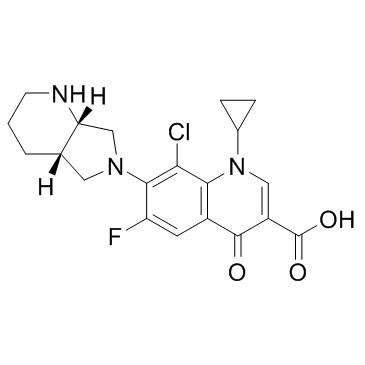151213-16-0
| Name | BAY-Y 3118 |
|---|---|
| Synonyms |
08VLU38WTI
8-Chloro-1-cyclopropyl-6-fluoro-7-[(4aS,7aS)-octahydro-6H-pyrrolo[3,4-b]pyridin-6-yl]-4-oxo-1,4-dihydro-3-quinolinecarboxylic acid BAY-Y-3118 FREE BASE 8-chloro-1-cyclopropyl-6-fluoro-7-[(4aS,7aS)-octahydro-6H-pyrrolo[3,4-b]pyridin-6-yl]-4-oxo-1,4-dihydroquinoline-3-carboxylic acid 3-Quinolinecarboxylic acid, 8-chloro-1-cyclopropyl-6-fluoro-1,4-dihydro-7-[(4aS,7aS)-octahydro-6H-pyrrolo[3,4-b]pyridin-6-yl]-4-oxo- |
| Description | BAY-Y 3118 is a new chlorofluoroquinolone with antimicrobial activity. |
|---|---|
| Related Catalog | |
| In Vitro | BAY-Y 3118 is potent against Haemophilhs influenzae, Moraxela catarrhalis, Acinetobacter baumannii, Xanthomonas maltophiia, gram-positive cocci, and anaerobes; MICs for 50%o of the strains (MIC50s) and MIC90s are ≤0.015 and ≤0.015, ≤0.015 and ≤0.015, 0.03 and 2, 0.25 and 0.5, 0.06 and 1, and 0.12 and 0.25 μg/mL, respectively[1]. The cellular concentration-to-extracellular concentration ratio of BAY-Y 3118 is higher than 6.3 at extracellular concentrations ranging from 2 to 100 mg/L. The uptake of BAY-Y 3118 is rapid, reversible and nonsaturable. The intracellular penetration of BAY-Y 3118 is significantly affected by environmental temperature and cell viability. BAY-Y 3118 reaches high intracellular concentrations within human polymorphonuclear leukocytes (PMNs) and remains active intracellularly[2]. All strains of L. monocytogenes and other Listeria spp. are highly susceptible; the MICs for these organisms ranges from 0.062 to 0.25 μg/mL. BAY-Y 3118 is rapidly bactericidal in vitro, with a postantibiotic effect occurring for 3 h after removal of the antibiotic. L. monocytogenes is eliminated from infected L929 cells treated with BAY-Y 3118, suggesting a bactericidal effect on the listeriae in these cells[3]. |
| In Vivo | Immunocompetent mice are rapidly cured by treatment with 4 mg every 12 h. Concomitantly, the levels of interleukin 6 and gamma interferon in mouse sera decline rapidly. In immunocompetent mice, treatment with 2 mg of BAY-Y 3118 every 12 h results in a greater initial reduction in the listerial counts in the organs than treatment with 2 mg of ampicillin every 12 h. BAY-Y 3118 completely eliminates L. monocytogenes from the livers and spleens of chronically infected nude mice[3]. |
| Cell Assay | Agar plates are prepared and used within 1 day after preparation. The inhibition of bacterial growth is also assessed in tissue culture medium (RPMI 1640 with L-glutamine and 10% fetal calf serum. In brief, 10000 cells of L. monocytogenes EGD are incubated for 8 h in the presence of the antibiotic. Thereafter, the number of bacteria is determined by plating in tryptose agar. The lowest concentration of the antibiotic that inhibited growth in this system is considered the minimal effective concentration in tissue culture medium[3]. |
| Animal Admin | Mice: Mice are treated intraperitoneally every 12 h with BAY-Y 3118 (1, 2, or 4 mg per animal in 0.2 mL of PBS starting 6 h postinfection). Control animals receive 0.2 mL of PBS only. At days 1, 3, and 6 postinfection, five mice from each group are killed by cervical dislocation and their spleens and livers are removed aseptically. The organs are homogenized in isotonic saline with Tenbroeck tissue grinders and are further diluted in isotonic saline. The bacterial counts per organ are determined by plating of appropriate dilutions of the homogenates in tryptose agar by a pour plate technique[3]. |
| References |
| Density | 1.5±0.1 g/cm3 |
|---|---|
| Boiling Point | 627.2±55.0 °C at 760 mmHg |
| Molecular Formula | C20H21ClFN3O3 |
| Molecular Weight | 405.850 |
| Flash Point | 333.1±31.5 °C |
| Exact Mass | 405.125549 |
| LogP | 2.05 |
| Vapour Pressure | 0.0±1.9 mmHg at 25°C |
| Index of Refraction | 1.654 |
